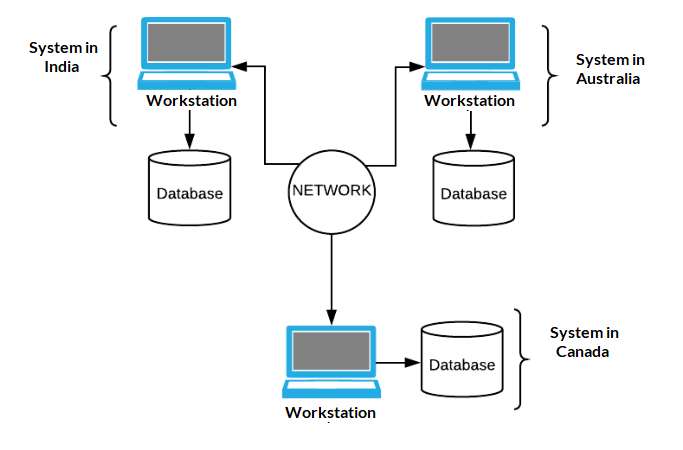
 Data Structure
Data Structure Networking
Networking RDBMS
RDBMS Operating System
Operating System Java
Java MS Excel
MS Excel iOS
iOS HTML
HTML CSS
CSS Android
Android Python
Python C Programming
C Programming C++
C++ C#
C# MongoDB
MongoDB MySQL
MySQL Javascript
Javascript PHP
PHP
- Selected Reading
- UPSC IAS Exams Notes
- Developer's Best Practices
- Questions and Answers
- Effective Resume Writing
- HR Interview Questions
- Computer Glossary
- Who is Who
Distributed Database Management System
In a distributed database management system, the database is not stored at a single location. Rather, it may be stored in multiple computers at the same place or geographically spread far away. Despite all this, the distributed database appears as a single database to the user. A diagram to better explain this is as follows:
As seen in the figure, the components of the distributed database can be in multiple locations such as India, Canada, Australia, etc. However, this is transparent to the user i.e the database appears as a single entity.
Types of Distributed Database Management System
The following are the types of Distributed Database Management System:
Homogeneous DDBMS
In a homogeneous DDBMS, the database management systems across all locations are uniform and based on the same data model. These database management systems are much easier to handle and the database can even be scaled if required.
Heterogeneous DDBMS
In heterogeneous DDBMS, the database management systems across different locations may be based on different data models such as relational, hierarchical, object oriented etc. This type of database systems are a result of later integration of individual database systems. They are quite complicated and difficult to manage.
Advantages
The distributed database can have the data arranged according to different levels of transparency i.e data with different transparency levels can be stored at different locations.
- If there were a natural catastrophe such as a fire or an earthquake, all the data would not be destroyed as it is stored at different locations.
- It is cheaper to create a network of systems containing a part of the database. This database can also be easily increased or decreased.
- Even if some of the data nodes go offline, the rest of the database can continue its normal functions.
Disadvantages
- The distributed database is quite complex and it is difficult to make sure that a user gets a uniform view of the database because it is spread across multiple locations.
- It is difficult to provide security in a distributed database as the database needs to be secured at all the locations it is stored. Moreover, the infrastructure connecting all the nodes in a distributed database also needs to be secured.
- It is difficult to maintain data integrity in the distributed database because of its nature. There can also be data redundancy in the database as it is stored at multiple locations.


